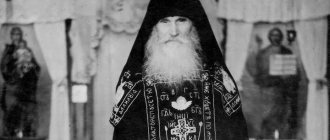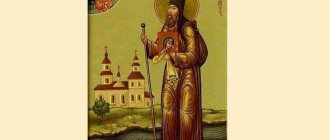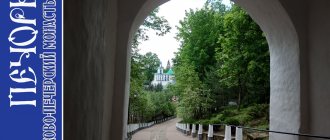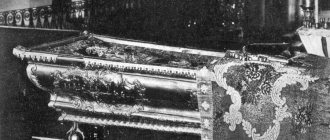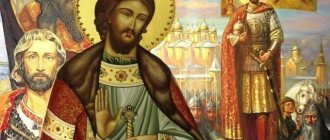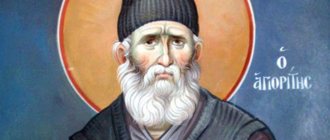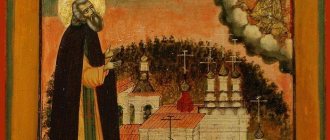Handwritten icon of St. Alexander of Constantinople. The image is made on a linden board with oak dowels, linen felt, chalk gesso, gold leaf, tempera, drying oil, varnish.
Icon painting workshop Radonezh. August, 2021. Sergiev Posad.
- Iconography of St. Alexander of Constantinople
- Life of St. Alexander of Constantinople
- How does the image of St. Alexander of Constantinople help?
- Buy an icon of St. Alexander of Constantinople
- Which icon to buy as a gift
- Calculate the cost of an icon
The icon of St. Alexander of Constantinople, presented on our website, embodies the most characteristic, canonical image of the saint. According to the tradition of the Russian Orthodox Church, Saint Alexander of Constantinople is depicted in full monastic vestments (cassock, cassock, belt, mantle, lectern on the chest, schema on the shoulders) and boots, with a blessing right hand and a scroll in his left hand.
The golden background of the icon depicts the half-length figure of St. Alexander of Constantinople. The saint is dressed in monastic vestments. In his hands the monk holds an open scroll with a saying from a psalm of David.
Correct, harmonious facial features personify the spiritual beauty of a celestial being. A stern facial expression, without excessive sensuality and emotionality, shows detachment from the world, concentration in serving the Lord. The face is painted with delicate ocher melts. The pinkish tones of the blush and lips contrast with the olive color of the sankir, which gives the face additional volume and expressiveness, softness and warmth.
Straight and wide folds of clothing set a certain rhythm and movement of the icon, expressing the complete orderliness of spiritual forces. Their strict geometric structure reveals the elasticity of spiritual energy. All elements of the icon are painted with thin, transparent melts, which give depth, softness, and unearthly airiness to the appearance of Alexander of Constantinople.
The icon of St. Alexander of Constantinople is made in the canonical style, in compliance with the centuries-old traditions of icon painting.
Life
The exact date of birth of Alexander of Constantinople is not known. presumably he was born in 350
It is known that the future Christian ascetic was born in Asia. Alexander went to Constantinople to receive his education. Upon reaching adulthood, he entered military service. In his free time from official duties, Alexander read spiritual literature.
Saint Alexander of Constantinople
Historians describe him as a very honest, God-fearing and virtuous person.
- After studying the Old and New Testaments, the young man decides to sell all his property and distribute the proceeds to the poor and needy. That's what he does. Alexander learned that in Syria there lived ascetics in the cenobites, who completely devoted themselves to prayer and worship. It is there that he subsequently goes, leaving his former life, service and friends.
- In the monastery he found the abbot Elijah and fervently began to ask the elder to accept him as a monk. For four years Alexander practiced asceticism, fulfilling all obediences and constantly praying. One day, Alexander began to ponder whether it was possible to completely stop worrying about food and clothing and completely rely on the providence of God, praying and glorifying His name. This thought took possession of him so much that Alexander decided to retire into the desert, having received the blessing of the abbot.
- When leaving the monastery, the monk took with him only the Gospel and nothing else. He spent seven long years in the desert completely alone. But the Lord showed him a revelation in which he called upon him to preach to pagan nations and convert them to the Christian faith. The Monk Alexander fulfilled the will of God. Not far from the place where Alexander labored, there was a settlement of pagans. Arriving there, the monk set fire to the pagan temple. He waited for the residents who came running to the fire and began to preach to them. In the end, both the city leader, Ravul, and the local residents believed in Christ. And the hermit went back to the desert.
Venerable Alexander of Constantinople
Life of St. Alexander of Constantinople
The Monk Alexander, the founder of the monastery of the Unsleeping Ones, was born in Asia and received his education in Constantinople.
He was in military service for some time, but he was attracted by a different calling: he left the world and took monastic vows in one of the desert Syrian monasteries near Antioch under the leadership of Abbot Elijah. He spent four years in strict obedience and monastic exploits, after which he received the blessing of the abbot to live in the desert. When leaving for the desert, the monk took nothing with him from the monastery except the Gospel. The monk labored in the desert for seven years. Then the Lord called him to preach to the pagans. The saint converted the local mayor Ravul to Christ, who was subsequently awarded the rank of hierarch and ruled the episcopal see in the city of Edessa for 30 years. At the same time as Ravul, all local residents received Baptism, and before the sacrament they burned their idols in the square. Having confirmed the converts in the faith, the Monk Alexander again went into the desert, where he accidentally fell into a cave of robbers. Not afraid of the death that threatened him, he preached the Gospel to them and convinced them to repent. Indeed, all the robbers sincerely repented, accepted Holy Baptism, and turned their den into a monastery, where they remained in repentance and prayer. The Monk Alexander appointed them an abbot, gave them a charter, and he himself withdrew even further into the desert. For several years he lived completely alone. But even there, lovers of silence began to flock to the monk. A monastery arose with up to 400 monks. Wanting to establish continuous praise to the Lord in this monastery, the monk prayed for three years that the Creator would reveal His will to him and, having received a revelation, introduced the following order in the monastery: all the monks were divided into 24 prayer guards. Taking turns every hour, day and night, they sang the psalms of David in two voices, interrupting only for the duration of the Divine Service. The monastery received the name “unsleeping” because the ascetics sang songs to God around the clock. The Monk Alexander ruled the monastery on the Euphrates for twenty years. Then, leaving one of his disciples, the experienced elder Trophimus, as abbot, he set off with selected brethren to the cities bordering Persia, preaching the Gospel among the pagans. After this missionary journey, the Monk Alexander and his monks lived for some time in Antioch. There he built a church, a hospital and a hospice for the residents of the city with funds that abundantly came to his disposal from the merciful Antiochians. However, due to the machinations of evil envious people, the Monk Alexander was forced to retire to Constantinople. Here he founded a new monastery, in which he also introduced the rule of “non-sleeping”. In Constantinople, the Monk Alexander and his monks suffered from Nestorian heretics, suffering beatings and imprisonment. After the storm of heretical unrest had passed, the Monk Alexander spent the end of his life in the Constantinople monastery he founded. He died at a very old age around 430, after 50 years of continuous monastic exploits.
See also: “ The Life of our Venerable Father Alexander, the founder of the monastery of the never-sleeping” as presented by St. Demetrius of Rostov.
Miracles and help
Already during his lifetime, through his prayer, Alexander performed inexplicable miracles. One of the striking examples was the debate between pagan philosophers and Alexander, organized by the Byzantine emperor Constantine, who was reproached for changing religion in the state. The philosopher began to speak, but Alexander, in the name of Christ, forbade him to continue. As a result, he could no longer utter a single word. Only by admitting that he was wrong did he speak again and believe in God.
Important! Prayer to the saint helps to collect thoughts and get rid of distraction. Before starting to read long akathists or psalms, it is advised to turn to St. Alexander with a request to give strength and inspiration to read prayers.
How does the icon of St. Alexander of Constantinople help?
Through the icons of His saints, the Lord sends us what we ask for, useful for our souls. The saints, just like us, who have walked the earthly path, know our needs. They experienced the same experiences, overcame similar earthly difficulties. When we ask a saint for intercession, we ask that he convey our prayer to God and that the saint’s prayers will be heard faster than our sincere appeal to them. The icon of St. Alexander of Constantinople helps to establish a prayer connection with the patron saint. Having before us the visual image of Saint Alexander, our prayer is not dissipated into empty ideas and dreams. And according to the faith of the one who asks, the Lord, through His saints, gives us what we ask.
They pray to St. Alexander of Constantinople:
— About strengthening faith — About help in organizing earthly affairs — About healing of bodily and spiritual infirmities.
Truly wonderful is God in His saints! Dear believers, brothers and sisters! Do not doubt the help of St. Alexander! Open your heart to him in sincere prayer and he will hear us, heal spiritual and physical infirmities, and help in the successful arrangement of earthly affairs.
Do not forget that in order for a miracle to happen, we ourselves must take care: regularly, with attention, read the prayer, do deeds of faith and love. And don’t forget to give thanks: to thank all the people sent to us by the grace of God to solve our life’s troubles, who shared our joy and sorrow. To thank the Saint, whose prayerful support our heart yearned for, because how many people pray to him for help, but he heard and helped us too. And most importantly, thank the Lord for His boundless love for mankind. He gave the world His saints and every second helps us, people who hope for His great mercies.
Everything in the world happens according to the wise providence of God. Difficulties and sorrows, success and joys. Through earthly trials the Lord strengthens us. By helping each other, praying to the heavenly saints, we are more firmly united in the One Church of Christ. And we believe that Saint Alexander will hear all our prayers and show us the boundless mercy of our Lord Jesus Christ. Thank God for everything!
Buy an icon of St. Alexander of Constantinople
In the Radonezh icon painting workshop you can buy or order a hand-written icon of the Holy Venerable Alexander of Constantinople. Call us and we will help you choose a plot, a compositional solution for the icon, its optimal size and design, or we will write an icon according to your sample.
Free delivery throughout Russia. If desired, the icon can be consecrated in the Holy Trinity Sergius Lavra.
The image of St. Alexander of Constantinople, made by the icon painters of the Radonezh workshop, like any handmade icon, carries within itself the living warmth of human hands and a loving heart. Each icon painted with love is unique and inimitable.
Peace and goodness to you Dear brothers and sisters, and may the holy saint of God, Alexander of Constantinople, accompany you throughout your entire life’s journey.
Similar icons:
Christina of Caesarea 12000 ₽
Nikola Svyatosha 13000 ₽
Love Roman 13000 ₽
Makariy Kalyazinsky 14000 ₽
Reverence
Saint Gregory the Theologian already mentioned Saint Alexander in his eulogy to the people of Constantinople.
In the iconographic tradition, Saint Alexander is depicted as a saint in an omophorion, with the Gospel in his hands. This is how he appears in the deacon of the Church of St. Sophia in Ohrid, Macedonia (1050s); on the Menaion icon for August (beginning of the 17th century, TsAK MDA); in the wall minology of the Church of St. Nicholas in Pelinov (full size, 1717-1718).
In 1892, a church was built in Moscow in the name of Alexander, Archbishop of Constantinople, at the shelter of Basil-Caesarean guardianship, which has survived to this day (Butyrsky Val, 26).
Memorial Days
In historical descriptions, Alexander of Constantinople is presented as a man of high morality, possessing unquestioned authority among the Byzantines. He headed the Byzantine department during the reign of Tsar Constantine I the Great.
On a note! The monk became the first bishop of consecrated Constantinople. This man throughout his life demonstrated unshakable faith in Jesus Christ and, through his own example of asceticism, proved that God’s providence will never leave a true believer Christian in trouble.
St. Alexander of Constantinople
Saint Mitrofan became the first bishop of Constantinople, and after his death, control of the eastern half of the church passed to Alexander I.
Just at that time, many Greek philosophers came to Emperor Constantine and began to reproach him for patronizing Christians. “Is it reasonable,” they said, “to forget the faith of our fathers and grandfathers for the sake of some new faith? Let Christians first prove to us that their God is truly more powerful than ours!” “For me personally,” answered Konstantin, “this issue has been resolved long ago. But if you insist, I agree. Choose the wisest from your midst, arrange a debate with the Christian bishop, and let all the people witness your humiliation.”
Having received such an answer, the pagans rejoiced at the opportunity to humiliate Christians and, after consulting among themselves, they chose the wisest and most eloquent philosopher for the debate. They then let Alexander know that they were ready to meet with him at any time for a theological dispute. “The will of the king is law for me, just like the will of the Lord,” the bishop said humbly. “I accept the challenge not for my own sake, but for the sake of strengthening the faith of Christ.”
He himself remained completely calm, but the priests surrounding him became worried. “Our enemy is cunning and cunning,” they told Alexander, “for all pagan philosophers spend their lives in everyday disputes and therefore are very skilled in this craft. Their tongue is resourceful, their mind is sharp, their soul is cunning. If you, father, are not experienced in Hellenic philosophy, it is better not to accept this challenge - refuse the debate under some pretext or leave this matter to someone else.” “It would be good for us,” the bishop objected, “if we ran away from every street loudmouth who makes money by teaching simpletons idle talk and idle thinking. Is not our Lord with us? And if so, then let even the devil himself come against me. With God’s help, I will somehow be able to humiliate him.” This is what Alexander said, having great faith in God.
On the appointed day, many Christians and pagans gathered in one of the squares of Constantinople to attend the dispute. Both opponents spent a sleepless night. The philosopher, although he was already a man of much knowledge, sat until the morning with his books. Alexander devoted the night to prayer. And so, at a sign from the king, the philosopher emerged from the crowd of like-minded people, ready to unfold before the people all the deceitful brilliance of his art, but then Bishop Alexander exclaimed: “In the name of my Lord Jesus Christ, I command you to be silent!” And immediately the philosopher lost his tongue, he was speechless and could not utter a word, despite all his efforts. His powerlessness before the Higher Power was so obvious that the pagans were horrified. Many of them fled.
After waiting for some time, the bishop said: “If this man still has something to say, then let him speak.” The speech immediately returned to the philosopher, but instead of blaspheming Christ, he began to glorify Him, and then confessed to everyone his past errors and renounced them forever.
Some time later, Alexander was once again able to show the townspeople the miraculous power of his prayer. Everyone knew that Emperor Constantine was greatly saddened by the schism that occurred among Christians after the Council of Nicea (https://www.proza.ru/2011/05/27/180). Many of the Arians then renounced their errors only in words, but remained heretics in their souls. Meanwhile, Constantine most of all wanted to see the church fathers reconciled, and Arius return to Orthodoxy. The courtiers, among whom were many secret Arians, decided to take advantage of this. Thanks to their efforts, Arius was returned from exile and arrived in Constantinople to meet with the emperor. In words he renounced his teaching, but in reality he continued to follow it. Going to see Constantine, this crafty man hid a scroll on his chest, where all the provisions of his heretical faith were outlined, after which he entered the throne room. Konstantin asked:
Abode of the “Unsleeping Ones”
One day a hermit wandered into a cave where robbers lived. Alexander was immediately captured, but he, showing courage and boldness, remained calm and preached the Gospel. As a result, all the robbers were baptized and repented of their actions.
A monastery was formed on the site of their home. The Monk Alexander appointed them an abbot, and he himself went into solitude, into the desert.
Venerable Alexander, founder of the monastery of the “Unsleeping Ones”
- But over time, people who wanted to repeat the monk’s feat began to come to his lonely monastery and remained with him in prayer. This is how a monastery appeared, in which 400 monks settled.
- Alexander began to think about the possibility of organizing continuous praise to the Lord in the monastery. But he did not dare to talk about this with his brothers. For three years the monk prayed to God to send him a revelation with an answer to the question of whether such a charter was acceptable to the Almighty. And he got it.
- It was decided to establish a new order of praising the Creator. The monks were divided into twenty-four prayer guards. Changing hourly, they sang psalms. Only during the Divine service was the psalmody interrupted. Due to the fact that songs of praise to God are sung in the monastery around the clock, the monastery received its name “unsleepless”.
- Historical sources indicate that Alexander remained abbot of the monastery on the Euphrates River for about 20 years. After this, at the command of God, he went with selected monks to different cities with the Gospel sermon. Many villages on the border with Persia were then pagan. For some time, the venerable elder settled with the brethren in Antioch. There, at the expense of benefactors, he built a church, a hospice and a hospital.
Alexander spent the last years of his life in Constantinople, in the monastery that he built. During the invasion of heretics, he and his monks had a hard time. There were beatings and imprisonment.
When the storm passed, the elder returned to his monastery, where he died at a venerable age. Alexander lived as an ascetic for almost 50 years.
